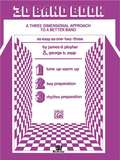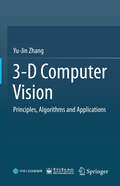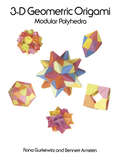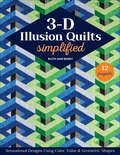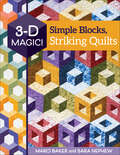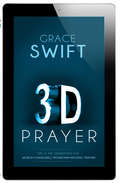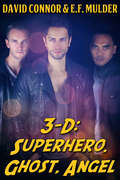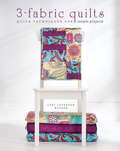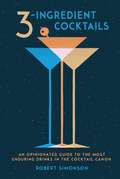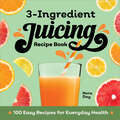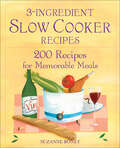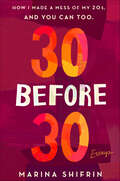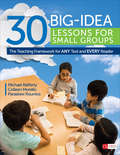- Table View
- List View
3-D Band Book: Conductor
by James D. Ployhar George B. ZeppThe 3-D Band Book is a three-dimensional approach to rehearsal preparation. This complete tune up/warm up program will reduce rehearsal stress and permit greater accomplishment with less effort. The overall preparedness that this book provides will make every rehearsal a more rewarding and enjoyable experience. The book is divided into three parts: tune up/warm up, key preparation, and rhythm preparation. In addition, there are three pages of harmony and ear training which will provide the basic knowledge necessary for relating to the exercises and chorales found in the book.
3-D Cinema and Trauma: Poetics of Remembrance and Loss
by Dor FadlonThis book examines 3D cinema across the early 1950s, the early 1980s, and from 2009 to 2014, providing for the first time not only a connection between 3D cinema and historical trauma but also a consideration of 3D aesthetics from a cultural perspective. The main argument of the book is that 3D cinema possesses a privileged potential to engage with trauma. Exploring questions of representation, embodiment and temporality in 3-D cinema, the book takes an interdisciplinary approach, offering a compelling analysis to a combination of box office favorites and more obscure films, ranging across genres such as horror, erotica, fantasy, science fiction, and documentaries. Weaving theoretical discussions and film analysis this book renders complex theoretical frameworks such as Deleuze and trauma theory accessible.
3-D Computer Graphics
by Samuel R. BussThis introduction to 3D computer graphics emphasizes fundamentals and the mathematics underlying computer graphics, while also covering programming techniques using OpenGL, a platform-independent graphics programming environment. The minimal prerequisites make it suitable for self-study or for use as an advanced undergraduate or introductory graduate text as the author leads step-by-step from the basics of transformations to advanced topics such as animations and kinematics. Accompanying software, including source code for a ray tracing software package, is available freely from the book's web site.
3-D Computer Vision: Principles, Algorithms and Applications
by Yu-Jin ZhangThis textbook offers advanced content on computer vision (basic content can be found in its prerequisite textbook, “2D Computer Vision: Principles, Algorithms and Applications”), including the basic principles, typical methods and practical techniques. It is intended for graduate courses on related topics, e.g. Computer Vision, 3-D Computer Vision, Graphics, Artificial Intelligence, etc. The book is mainly based on my lecture notes for several undergraduate and graduate classes I have offered over the past several years, while a number of topics stem from my research publications co-authored with my students. This book takes into account the needs of learners with various professional backgrounds, as well as those of self-learners. Furthermore, it can be used as a reference guide for practitioners and professionals in related fields. To aid in comprehension, the book includes a wealth of self-test questions (with hints and answers). On the one hand, these questions help teachers to carry out online teaching and interact with students during lectures; on the other, self-learners can use them to assess whether they have grasped the key content.
3-D Engineering
by Vicki V. MayHow did somebody come up with the idea for bridges, skyscrapers, helicopters, and nightlights? How did people figure out how to build them? In 3D Engineering: Design and Build Your Own Prototypes, young readers tackle real-life engineering problems by figuring out real-life solutions. Kids apply science and math skills to create prototypes for bridges, instruments, alarms, and more. Prototypes are preliminary models used by engineers--and kids--to evaluate ideas and to better understand how things work. Engineering design starts with an idea. How do we get to the other side of the river? How do we travel long distances in short times? Using a structured engineering design process, kids learn how to brainstorm, build a prototype, test a prototype, evaluate, and re-design. Projects include designing a cardboard chair to understand the stiffness of structural systems and designing and building a set of pan pipes to experiment with pitch and volume. Creating prototypes is a key step in the engineering design process and prototyping early in the design process generally results in better processes and products. 3D Engineering gives kids a chance to figure out many different prototypes, empowering them to discover the mechanics of the world we know.
3-D Geometric Origami
by Rona Gurkewitz Bennett ArnsteinThis innovative book -- among the first to combine the art of origami with making polyhedra-based models -- shows papercrafters how to create over 60 different polyhedral from origami units. Comprised of modules made of single sheets of paper, the figures offer model builders and math students alike a stimulating entrée into the world of three-dimensional geometric origami.Origamists are initially introduced to a number of preliminary folds that will aid in constructing a variety of figures. Step-by-step instructions and clearly outlined diagrams then show how to create polyhedral ranging from a relatively simple tetrahedron and cube to such mind-boggling fabrications as the double pentagonal pyramid, a truncated hexadecahedron and the 92-faced snub dodecahedron. You'll also learn to construct these intriguing polyhedral: a stellated icosahedron, an equilateral triangle dodecahedron, and a truncated octahedron.Graded according to difficulty, these multifaceted projects will not only challenge devotees of the ancient Japanese art of paper folding but will be useful in classroom demonstrations of mathematical principles.
3-D Illusion Quilts Simplified: Sensational Designs Using Color, Value & Geometric Shapes
by Ruth Ann BerryTake your quilting game to the next dimension! Expanding on the bestseller Stunning 3D Quilts, Simplified, this sequel takes your quilting journey to the next level. Tackle the 12 captivating projects, from wall hangings to king-sized quilts, and discover how to swap out identical triangles for strips, making piecing easy. Unleash your inner quilt designer with a section on creating your own 3-D quilt, equipped with isometric graph paper for sketching your unique patterns. The book seamlessly connects the projects to design lessons, allowing your project to come to life. From tools and fabric to design and color, this book prepares you for a quilt-making adventure like no other. Create 12 projects featuring a variety of color schemes and designs, including stars, hearts, lattices, and other continuous/repeating patterns Bring your ideas to life and sketch your quilt design using the included isometric graph paper Resize your projects from a wall hanging to a king-sized quilt by changing the width of the starting strip, allowing for a personalized quilting experience
3-D Magic! Simple Blocks, Striking Quilts
by Marci Baker Sara NephewJust like magic — 3D Blocks for Deceptively Easy Quilts Simple piecing and thoughtful fabric choices make dramatic 3D quilts! Prepare to be amazed by simple techniques that make flat fabrics into surreal landscapes and rising cubes with various textures. The key is not crumpling, folding, or bunching material but rather playing with light, medium, and dark fabric. You'll learn to piece 13 easy 3D quilt blocks without y-seams or set-in seams. The magic lies in the simplicity of the piecing method taught in the book. You can individually select and piece your fabric or use strip piecing! Make 13 stunning 3D blocks, and explore instructions for creating the blocks in alternate sizes. Browse through a large gallery of quilts by imaginative quilters for inspiration Includes seven distinct quilt projects to get you started
3-D Prayer: This is The Generation for World-Changing, Mountain-Moving Prayer
by Grace SwiftIt was the longest ride of Grace Swift&’s life. For nine hours she could think only about the excruciating task awaiting her: identifying the body of her youngest son. He had been a radical prayer warrior and Christian who placed his confidence in God despite his personal imperfections. But in a random act of murder, he was gunned down in his youth. Drawing upon her son&’s fervent commitment to Christ, Grace has crafted a message for all young Christians who want to change the world through prayer: Personal perfection is not a prerequisite for being used by Jesus. Confidence in His power within you will enable you to accomplish great things for Him. Grace will challenge you not to limit God because of your youth. She will build your confidence that through the Holy Spirit in you, you can live every day &“on the offensive&” and enjoy a mountain-moving, world-changing life of prayer.
3-D Seismic Interpretation
by M. Bacon R. Simm T. RedshawThis book introduces geophysicists and geologists to the technique of interpreting 3-D seismic data. The topics it covers include basic structural interpretation and map-making; the use of 3-D visualization methods; interpretation of seismic amplitudes; the generation and use of AVO and acoustic impedance datasets; and time-lapse seismic mapping. Written by professional geophysicists with many years of working experience in the oil industry, the book will be indispensable for graduate students, researchers, and new entrants into the petroleum industry.
3-D: Superhero, Ghost, Angel
by David Connor E. F. MulderA superhero, a ghost, and an angel walk into a bar. Dario, the ghost, feels a sense of déjà vu. He died in a bar, and it seems like he might be reliving that terror over and over again. This time, however, there’s an angel at his side, Dondre, and that brings some comfort.After a few to many drinks, Dwight, the superhero, reveals his animosity toward angels. He’s angry angels get all the credit when someone survives a deadly incident. People think angels are real, while most believe superheroes are only found in fiction.When a wave of deadly crime sweeps across the country, Dario and Dondre become the prime suspects. Who is setting them up? All signs point to Dwight, the disgruntled superhero. Can the ghost and the angel prove themselves innocent? Will someone else die? And what of Dwight? Is he friend or foe?
3-Fabric Quilts: Quick Techniques for Simple Projects
by Leni Levenson WienerE A S Y A S 1 - 2 - 3 ! Selecting fabrics and making great quilts have never been easier! in 3-Fabric Quilts, Leni Levenson Wiener gives you the tools to make twelve fantastic quilts that each require only three fabrics. With each quilt composed of geometric squares, rectangles and strips, cutting and piecing have never been so fast and simple. INSIDE, YOU'LL FIND: Advice on choosing the three fabrics, including tips on understanding color, value and print scale, making fabric shopping easier than ever Illustrated instructions for twelve 3-fabric quilts, each with yardage requirements and instructions for a small and large size Basic rotary cutting, piecing and fi nishing instructions Fun, fresh, contemporary fabrics, layouts and patterns- perfect for gifts or to decorate your own home
3-Ingredient Cocktails: An Opinionated Guide to the Most Enduring Drinks in the Cocktail Canon
by Robert SimonsonA collection of the greatest drinks of all time, modern and classic, all of which conveniently feature only three ingredients. 3-Ingredient Cocktails is a concise history of the best classic cocktails, and a curated collection of the best three-ingredient cocktails of the modern era. Organized by style of drink and variations, the book features 75 delicious recipes for cocktails both classic (Japanese Cocktail, Bee's Knees, Harvey Wallbanger) and contemporary (Remember the Alimony, Little Italy, La Perla), in addition to fun narrative asides and beautiful full-color photography.
3-Ingredient Juicing Recipe Book: 100 Easy Recipes for Everyday Health
by Nora DayOptimize your health with simple homemade juices Looking for a delicious way to improve your health and wellness? The answer is simple: juicing. This juicing recipe book shows you just how easy it is to prepare refreshing and nutritious drinks using only three ingredients. You'll find recipes that align with your specific health goals, whether you want to lose weight, boost protein intake, or simply start your mornings with a tasty jolt. What sets this juicing book apart: Healthy habits—Make juicing a regular part of your healthy lifestyle as you explore the building blocks of a great juice, and get a rundown of the vitamins and minerals found in different produce. Easy recipes—Discover 100 delectable drinks that manage to pack a nutritional punch while only requiring three ingredients, including recipes for antioxidant juices, cleansing juices, and juices for weight loss. Tips and tricks—Ensure your juicing goes smoothly with advice on everything from finding the right juicer to the best way to store precut fruits and veggies. Jump-start your juicing journey with this simple and satisfying recipe book.
3-Ingredient Slow Cooker Recipes: 200 Recipes for Memorable Meals
by Suzanne BonetPeople love the convenience of their slow cookers. What could be better than walking in the door after a hard day's work to the smell of beef stew, ready and waiting? A beef stew that only requires three ingredients, that's what!The problem with most slow cooker recipes is that they require lots of ingredients and steps before you actually "fix it and forget it." Not this book-these are truly simple recipes, and best of all, they are memorable, not mushy!You'll find recipes like:*Rosemary Lamb Stew*Chicken Curry*Three-Alarm Chili*Spicy Pot Roast with Onions*Coq au Vin*Pork Roast with 40 Cloves of GarlicPlus, you'll find recipes for desserts like cheesecake and custard and appetizers like chicken wings and artichoke dip!
3-Minute Horsemanship
by Vanessa BeeA book especially written for the time-starved horse owner! Do you day after day make a promise to train yourself and your horse to be better at something, but when you get to the barn there just doesn't seem to be enough time? Don't worry, what really matters is the quality of the training you do manage to fit in. It really is possible to carry out good quality, progressive training with a horse in only three minutes a day. Educator and horse trainer Vanessa Bee's light bulb moment was when she realized that if a training session had a realistic goal, every horse achieved the goal in under three minutes. This led her to create techniques appropriate for use in brief digestible lessons that ultimately produce significant gains in short sessions. This refreshing new method offers 35 ground exercises, 24 ridden exercises, and 25 real world exercises that will get you out and about with a safe, sane, well-trained horse.
3-System Theory of the Cognitive Brain: A Post-Piagetian Approach to Cognitive Development (Essays in Developmental Psychology)
by Olivier Houdé3-System Theory of the Cognitive Brain: A Post-Piagetian Approach to Cognitive Development puts forward Olivier Houdé’s 3-System theory of the cognitive brain, based on numerous post-Piagetian psychological and brain imaging data acquired from children and adults. This ground-breaking theory simultaneously anchors itself in a deep understanding of the history of psychology and fuels current debates on thinking, reasoning and cognitive development. Spanning the long-term history of psychology, from Plato and Aristotle to more current experimental psychology, this pioneering work goes beyond the approaches of Kahneman (i.e. System 1 theory) and Piaget (i.e. System 2 theory) to put forward a theory in which the inhibitory-control system (i.e. System 3) takes precedence. Houdé argues that the brain contains a third control system located in the prefrontal cortex which is dedicated to inhibiting Kahneman’s intuitive heuristics system and activating Piaget’s logical algorithms system anywhere in the brain on a case-by-case basis, depending on the goal and context of the task. 3-System Theory of the Cognitive Brain simultaneously explains the early logical abilities discovered in babies, the dynamic, strategic and non-linear process of cognitive development in children, and the fast heuristics and biases observed in adults. Houdé considers the exciting implications of this theory on neuro-education using examples from the classroom. This book is essential reading for students and researchers in cognitive development and education, child psychology, reasoning and neurosciences.
3.11: Disaster and Change in Japan
by Richard J. SamuelsOn March 11, 2011, Japan was struck by the shockwaves of a 9. 0 magnitude undersea earthquake originating less than 50 miles off its eastern coastline. The most powerful earthquake to have hit Japan in recorded history, it produced a devastating tsunami with waves reaching heights of over 130 feet that in turn caused an unprecedented multireactor meltdown at Fukushima Daiichi Nuclear Power Plant. This triple catastrophe claimed almost 20,000 lives, destroyed whole towns, and will ultimately cost hundreds of billions of dollars for reconstruction. In 3. 11, Richard Samuels offers the first broad scholarly assessment of the disaster's impact on Japan's government and society. The events of March 2011 occurred after two decades of social and economic malaise-as well as considerable political and administrative dysfunction at both the national and local levels-and resulted in national soul-searching. Political reformers saw in the tragedy cause for hope: an opportunity for Japan to remake itself. Samuels explores Japan's post-earthquake actions in three key sectors: national security, energy policy, and local governance. For some reformers, 3. 11 was a warning for Japan to overhaul its priorities and political processes. For others, it was a once-in-a-millennium event; they cautioned that while national policy could be improved, dramatic changes would be counterproductive. Still others declared that the catastrophe demonstrated the need to return to an idealized past and rebuild what has been lost to modernity and globalization. Samuels chronicles the battles among these perspectives and analyzes various attempts to mobilize popular support by political entrepreneurs who repeatedly invoked three powerfully affective themes: leadership, community, and vulnerability. Assessing reformers' successes and failures as they used the catastrophe to push their particular agendas-and by examining the earthquake and its aftermath alongside prior disasters in Japan, China, and the United States-Samuels outlines Japan's rhetoric of crisis and shows how it has come to define post-3. 11 politics and public policy.
30 (Rick Steves Walk Ser.)
by Rick StevesRick Steves Pocket guidebooks truly are a "tour guide in your pocket.” Each colorful, compact 280-page book includes Rick's advice for prioritizing your time, whether you're spending 1 or 7 days in a city. Everything a busy traveler needs is easy to access: a neighborhood overview, city walks and tours, sights, handy food and accommodations charts, an appendix packed with information on trip planning and practicalities, and a fold-out city map.Rick Steves Pocket Barcelona includes the following walks and tours: Ramblas Ramble Barri Gotic and Cathedral Tour Picasso Museum Tour Eixample Walk Sagrada Familia Tour
30 Before 30: Essays
by Marina ShifrinA charming, relatable and hilarious collection of essays documenting a young woman's attempt to accomplish thirty life goals before turning thirty.Something was nagging Marina Shifrin. As a freshly minted adult with student loan payments, a barely hospitable New York apartment, a “real” job she hated that paid her enough to get by if she also worked two other jobs, something needed to change. Over a few bottles of Two Buck Chuck, Marina and her friend each made lists of thirty things they’d do before the age of thirty. The first thing on Marina’s list was, “Quit My Shitty Job.” So she did, and just like that the List powered her through her twenties.In 30 Before 30, Marina takes readers through her list and shares personal stories about achieving those goals. Ranging in scope from the simple (Ride A Bike Over the Brooklyn Bridge, Donate Hair) to the life-changing (Move to A Different Country, Become internet Famous), each story shows readers that we don’t all have it figured out, and that’s okay. But for Marina, she did become internet famous (a viral video of her quitting her job after moving to Asia has nearly 19 million views on You Tube) and now writes for Comedy Central’s hit show @Midnight, is also an in-demand stand up, and had a very popular Modern Love column published in the New York Times. None of that would have happened if she didn’t start her list that night. Thank you, Two Buck Chuck.Told with humor and heart, 30 Before 30 will entertain, motivate, and challenge readers to get out of their comfort zones and live their best lives.
30 Big-Idea Lessons for Small Groups: The Teaching Framework for ANY Text and EVERY Reader (Corwin Literacy)
by Michael J. Rafferty Colleen A. Morello Paraskevi Rountos30 Big Idea Lessons for Small Groups provides an amazing framework, with a bank of engagement tools, that gets students interacting with texts. Follow this unique 4-part process to develop students’ literal, inferential, evaluative, and analytical skills: Engage: Before Reading Students use a tactile tool like a topic card or a pyramid Discuss: During Reading Students read and mark up a short text Deep-See Think: After Reading Students re-read and revise their interpretations together Connect: After Reading Students begin to transfer their understandings to other texts
30 Big-Idea Lessons for Small Groups: The Teaching Framework for ANY Text and EVERY Reader (Corwin Literacy)
by Michael J. Rafferty Colleen A. Morello Paraskevi Rountos30 Big Idea Lessons for Small Groups provides an amazing framework, with a bank of engagement tools, that gets students interacting with texts. Follow this unique 4-part process to develop students’ literal, inferential, evaluative, and analytical skills: Engage: Before Reading Students use a tactile tool like a topic card or a pyramid Discuss: During Reading Students read and mark up a short text Deep-See Think: After Reading Students re-read and revise their interpretations together Connect: After Reading Students begin to transfer their understandings to other texts
